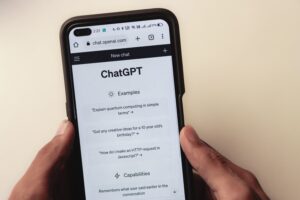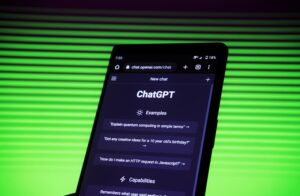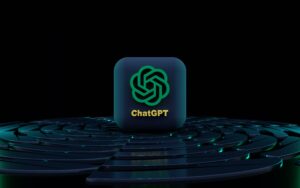
How To Use Chat GPT For Studying, Research, and More!
Learning how to use Chat GPT ethically for school is important to learn now more than ever. Since Chat GPT launched in November of 2022, it has been one of the quickest machine learning software to be adopted and has been the most transformative tool since Google in 1998. Because the technology is fairly new, the professional ethics of Chat GPT is still up for contention. However one thing is for certain, its usage has no signs of slowing down.
In this blog, we’ll find out the answers to, “Is Chat GPT safe?” and how students and professionals can best utilize it.
The Definition and History of Chat GPT
In understanding how to use Chat GPT, we must first learn its history. Chat GPT is an “artificial intelligence tool” and a machine learning software that generates anything from stories, poems, songs, and answers based on user-written “prompts” or questions. Launched in November 2022, Chat GPT was created by the organization Open AI which was partially founded by Elon Musk and is run by CEO and co-founder, Sam Altman. The Chat GPT website which can be accessed by creating an account with Open AI operates like a normal chatbot where you get replies after sending your questions or prompts.
The first version of the tool, GPT-1, was created by Open AI in 2018 and contained 117 million parameters, and was trained off of a dataset of web pages. The second version, GPT-2 was released in 2019 but because of concerns about the tool to generate propaganda and fake news, it wasn’t open to the public. The second version had 1.5 billion parameters and was one of the largest language models at the time. GPT-3 was released in June 2020 and has 175 billion parameters, the largest language model to this day.
Chat GPT 4
Forbes reported the launch of the latest version of Open AI’s language model system, GPT-4, in March 2023 and can be accessed with a paid subscription while the free version is available on GPT-3.5. Open AI claims this newer version is “safer and more responsive” however, it does have its limitations. According to the Forbes article, GPT-4 can give “hallucinated” facts and reasoning mistakes which can be concerning to most users.
The Usage Limitations of Chat GPT In School
When the University of Cambridge educators Dr. Vaughan Connolly and Dr. Steve Watson were asked where they stand on ChatGPT and whether it should be embraced or banned, they had very compelling arguments. Dr. Steve Watson, co-convener of the Faculty’s Knowledge, Power, and Politics research cluster brought up educators’ concerns over student use of Chat GPT to produce essays, coursework, and exams, Dr. Watson says educators should learn to adapt and ask themselves what they can do to mitigate these occurrences. Dr. Vaughan Connolly, on the other hand, acknowledges that the fast-paced growth from Chat GPT 3 to 4 and its widespread use has thrown “banning” out the window. He says the question rather should be whether to use Chat GPT in schools and how to do so “safely, effectively, and appropriately”. He also says that initiative should come from schools themselves at the risk of putting schools and their students at a disadvantage.
While there are risks in adapting to the usage of Chat GPT in schools, both educators also acknowledge its prowess. Connolly even says that it could be perilous for educators to ignore its development as Chat GPT has the makings of transformation that Google had in 1998. He says educators should “start engaging with it in a meaningful way.” Dr. Watson also used “transformative” to characterize the new language model system and also called it, “a hugely powerful assistive technology.”
 How Chat GPT Can Potentially Change Teaching and Learning In Schools
How Chat GPT Can Potentially Change Teaching and Learning In Schools
Knowing that adopting instead of shunning new technologies in the classroom is the way forward, Dr. Connolly and Dr. Watson have each shared how Chat GPT can potentially change teaching and learning in schools and how they’ve implemented it.
1. Critical Thinking
Dr. Steve Watson openly admits that one of his shortcomings in school was not knowing how to compactly express his many thoughts and ideas. Chat GPT, he says, can help students present their ideas in a much more clear and organized way that in turn also helps their professors understand them better. Because Chat GPT can easily summarize arguments and concepts, it can be used by professors with assessments especially when they are presented with limited time.
2. Verifying Claims
Dr. Vaughan Connolly has reportedly used Chat GPT in his GCSE computer science class and had his students verify certain claims, seek further details, and even challenge information.
3. Homework Revision Tool
Dr. Connolly has also tested Chat GPT for its ability to be a homework revision tool while using prompts that would allow him to take the perspective of students in various subjects and phases.
4. Essay Refinement
Using prompts, Dr. Connolly used Chat GPT and posed as a key stage 4 history student and had an “informative” back and forth with the tool on the subject of 19th-century cholera. The tool allows students to envisage situations that will help them with revising papers, checking their homework answers, and refining their essays.
5. Helping Students Who Use English As A Second Language
Another way Dr. Vaughan Connolly states Chat GPT is useful for helping postgraduate students whose second language is English. They can use the language model tool to clarify what they mean in writing or ask AI to rewrite their work in an academic style. Dr. Connolly says it reduces the translation burden on students and instead focuses on content instead of technical aspects of writing in a language they are not 100% familiar with.
The Chat GPT Controversy
By early 2023, new sources have begun reporting incidents of students plagiarizing their essays with the use of Chat GPT. In an article released by Forbes, about 89% of students admitted to using Chat GPT to complete their homework. This in turn has created challenges for educators surrounding “plagiarism, cheating, and learning.” Christian Terwisch, a Wharton MBA Professor, claims that an essay written with Chat GPT would garner “a B or a B- ” for an Ivy League MBA-level exam. Alex Lawrence, a Utah-based university professor said “This is the greatest cheating tool ever invented” after he prompted Chat GPT to tweet in his voice.
As soon as Open AI’s Chat GPT’s latest model went public, students were quick to use it to their advantage. A whole lot of them did enough for educators all over the world to stop and assess how they would go about this newest advancement. In a Business Insider article, professors grew weary of some essays passed by their students when they seemed very well written but contained misinformation. Philosopher professor at Furman University, Darren Hick, caught a student of his who turned in an essay that was AI-written after he ran it through Open AI’s Chat GPT detector and it scored 99%. That student failed his class. Indeed, AI plagiarism is becoming a bigger challenge to colleges than ever expected. Even with the existence of AI plagiarism checkers, proving that essays are AI-written is becoming quite challenging as well. This begs the question, is there a way we can learn how to use Chat GPT ethically without it being called plagiarism?
We know its usage won’t slow down and more students will eventually make use of it in academic settings. Academic institutions must lay the boundaries of what is and isn’t acceptable. Students also need to learn how to use new technological advances for actual good and not just temporary gain. Open AI created Chat GPT and it is very well revolutionizing the way research is done, but surely there are better ways of using it that aren’t for cheating purposes. We must lay out the ethics of Chat GPT and create clear guidelines for students to follow and academic institutions to implement.
 How Educators Can Use Chat GPT
How Educators Can Use Chat GPT
While some try to learn how to use Chat GPT in the most efficient way that doesn’t break the academic ethics code, some banned its use altogether. In January of 2023, New York City schools banned the use of Chat GPT. It is forbidden to use on all devices and networks across all New York public schools. The New York City Department of Education made their decision based on their concerns that the negative impacts of Chat GPT usage impede student learning. They were also concerned about the safety and accuracy of it. Since coming out with the ban, Open AI has stated to reassure teachers that they have begun developing mitigations that will help people identify text generated by their system. Overall, Open AI would like to work alongside educators to come up with solutions that help both students and teachers benefit from artificial intelligence.
While the threat is imminent to some, some educators are willing to adapt to artificial intelligence. Angela Duckwork, who’s a psychologist, has argued against banning Chat GPT and even proposed for educators to learn how to incorporate AI into the curriculum. “We have a choice here to lean in or run away”, says Kathy Hirsh-Pasek of Temple University in Philadelphia, who stated similarities to how educators chose to have calculators available to use during calculus classes. Knowing now that students are still able to learn while using calculators, Hirsh-Pasek also encourages educators to find ways to embrace Chat GPT’s abilities while still increasing critical thinking.
Here are some ways educators can use Chat GPT to their advantage while still upholding academic ethics.
Considering Chat GPT When Creating Course Goals
The American Psychological Association, more notably known as the organization that brought us the APA style format, has released an article that tells educators how to use Chat GPT as a learning tool. Their first step of advice is to “consider course goals”. Professor of Psychology, Daniel Oppenheimer from Carnegie Mellon University in Pittsburgh says, “There are going to be classes for which Chat GPT would be inappropriate, but in other settings, it could be a useful tool.” Educators can benefit a lot from determining whether or not Chat GPT can help them achieve their teaching goals. For instances that it won’t take away from a student’s learning, Chat GPT can help them as a tool because facts are easily accessible with it. But if the goal is to teach those very facts that are accessible by Chat GPT, then maybe it can be used at a different time.
Encourage Students’ Critical Thinking With Chat GPT
Professors Oppenheimer and Hirsh-Pasek have already started incorporating and learning how to use Chat GPT to encourage their students’ critical thinking. Oppenheimer teaches a course on human intelligence and stupidity. As an exercise, he encourages his students to compare text generated by Chat GPT with human-generated text. Professor Hirsh-Pasek on the other hand requires her honors psychology students to use Chat GPT to write a first draft and then edit a second draft with certain critiques, additions, and corrections.
Other ways professors have used Chat GPT for learning is by using it as an “interactive partner” as used by Gary Lupyan. The professor of psychology at The University of Wisconsin-Madison says Chat GPT can be used similarly to how you would speak with a colleague. While James W. Pennebaker, the Chat GPT can be asked about which theories are better. He says, “Students can learn to appreciate other arguments and see both sides objectively before establishing an opinion.”
Being Aware Of The Limitations and Cons of Chat GPT
Instead of overhauling test questions to try and “beat the system” or design questions, educators think Chat GPT can’t answer, the best solution might be to implement practices that would reduce all kinds of cheating. Chat GPT synthesizes information quickly and can very well answer multiple-choice-type questions. However, using open-ended assessments would be a lot harder to grade. While Chat GPT might be great at answering questions that require synthesis, it is still precisely the type of questions students must ask for them to learn.
The best way to get around this is to keep students motivated with the class material. Providing them feedback throughout that they will inevitably make part of their work will be hard to plagiarize. Explaining academic integrity to students very early on is important. Cheating might be an easy way out momentarily but it’ll eventually take away from a student’s ability to learn skills that they will need to succeed in their chosen careers.
Communicate To Students What Is Expected Of Them
Until all departments of education around the world come out with a universal rule regarding the use of AI, it is up to professors to set the parameters for their classes. Educators must communicate well and openly to their students what can and cannot be done during their course. Educators must be specific with instances where their students are allowed to use AI and when they are not. Similar to how some professors allow for open-book exams or use calculators in class. If the use of Chat GPT cannot be taken away from students, professors must at least ensure equity in that all students are allowed to do so, while still upholding academic integrity.
Educators Should Try Out Chat GPT For Themselves
Ultimately, the American Psychological Association urges teachers to try out Chat GPT first before they determine whether or not it can be used by their students. Learning new technology can be overwhelming but it can be an empowering tool for both students and educators. New things can oftentimes be scary but they are also an opportunity for growth and more learning.
How Students Should Use Chat GPT
Now that we’ve discussed how educators can use Chat GPT to their advantage, it’s time to show students how to use Chat GPT while upholding academic integrity. Open AI’s Chat GPT has many great uses and should not be limited to being a tool used for plagiarizing or cheating. We must see it as a way for us to learn faster and more effectively. Just as AI and Chat GPT continues to synthesize and gather new information that widens its language system, so should people as we enter a new world where AI and human learning coexist.
1. Using Chat GPT A Research Tool
Chat GPT is revolutionizing the way students search for information. Since Google came out in 1998, students are now presented with a tool that answers specific questions instead of providing a list of sources where they can get their answers. There’s a way to learn how to use Chat GPT for essays that does not involve plagiarism. Instead of creating a Chat GPT essay, you can use it as a research tool to answer your essay questions. It’s normal not to know the answers right away. The reason teachers like to give their students essay assignments is so they can assess how their students understand the coursework and encourage them to think independently. Chat GPT can be a great source of inspiration and an even better tool to throw questions at that will eventually get you to understand concepts that will get you closer to writing your essays.
AI detection tools are rampantly used by professors now that they’re aware of students turning in AI-written essays. Now more than ever is it beneficial to have a real professional writer assist you. For days that you are pressed for time and need an essay as soon as possible, instead of turning in an AI-plagiarized essay, try out Homework Help Global’s custom essay writing service in lieu instead. It’s 100% original and plagiarism-free.
2. Verifying and Checking Facts
Similar to how Professor Gary Lupman at The Univerity of Wisconsin-Madison makes use of Chat GPT like he would a colleague, make use of Chat GPT to challenge theories and verify facts. The great thing about Chat GPT is that it is like an encyclopedia that you can talk to. It is trained on vast amounts of data and can answer almost anything. Whenever students are away from their professors and don’t have access to their school libraries or specific books, it is the best time to consult Chat GPT. It most likely has the answer in its database. Students don’t always have access to speaking with professionals and can’t always ask a reputable source for answers, but Chat GPT can try to fill in those holes in your research the quickest way possible.
Because there are still limitations to Chat GPT, whenever possible, it’s still best to consult a human professional. If you’re looking to get tutored on specific subjects, Homework Help USA’s team of professional writers who have Ph. D.s and MAs are more than qualified to assist and answer you over a quick Zoom call. Try out our 1-on-1 tutoring services if your questions simply have to be answered by a real person.
3. Developing Plans or Schedules
One thing that isn’t as utilized by Chat GPT is its ability to plan for you. By telling Chat GPT through a prompt which days of the week you’re free, which days you prefer studying, which days you have classes, and have specific study durations, and target topics, it could create a study plan or class schedule for you. You could almost look at Chat GPT as a personal assistant that you have just tasked to plan your week, month, or even year for you! The best part is after Chat GPT answers your prompts, you can even refine it.
4. Identify Shortcuts or “Tricks”
Not only can Chat GPT help you with writing, but it can also help you solve complex math problems. Chat GPT has a wide collection of shortcuts and tricks that can solve complex STEM problems, ranging from basic physics to more complex engineering problems. For example, feeding the prompt “Find the sum of the first 1000 positive integers” will allow Chat GPT to generate not only the answer but the solution, effectively teaching you how it got to the answer of “500,500”. It can also supply you with different ways or a shortcut to get that same answer by using the prompt: “Use a less-known shortcut. State whether the shortcut works in all cases of the problem.” Chat GPT will now provide you with another solution that gets the same answer quicker. You can even take it up a notch by adding to the prompt to show you a visual representation. For those who find math challenging, Chat GPT is a great teacher.
Because of math’s complexity and the limitations of Chat GPT, it is still always best to have your solutions checked by a real professional. Homework Help USA also provides a service that allows students to get math solutions done.
5. Summarizing Long Form Texts And Extract Key Points
Another thing Chat GPT is incredibly good at is summarizing long-form texts and extracting key points. A task that is always expected from students. Luckily, Chat GPT makes for a great reading companion and you can easily make sense of voluminous text without necessarily reading its entirety. If the text is available online, try copying pieces of it and feeding it to Chat GPT while asking it to make a summary. While Chat GPT isn’t designed for summaries, there is a prompt that allows you to keep adding text even though there is a limit to how many words you can feed a prompt at a given time. Since Chat GPT responds to texts without waiting to get the entirety of it, use this prompt to fix that: “Whenever I provide a prompt, simply reply with a full stop (period). Keep doing this until I ask for a summary of all the text provided.” After this, you can keep adding parts of the long text bit by bit and then ask Chat GPT for a summary.
The best time to use this prompt is when you’re tasked with book reports or even case studies. Both of which are services that are offered by Homework Help USAgL. The risk in feeding Chat GPT with long prompts without having read the text yourself is there’s no way of knowing whether or not there are errors. In this case, you’re better off getting professional help from an actual writer who will read or have read your source material.
6. Improve Writing
The best way to learn how to use chat GPT for essays that don’t involve plagiarizing is by using it to improve your writing rather than do it for you. A problem you can face when getting AI to write your essays is that Chat GPT can make up events, figures, and concepts and present
them as facts. This is where the well-written misinformed essays come from that professors can see right through. Instead, even if you are not the most seasoned writer, create the first draft yourself and then make use of Chat GPT to polish certain areas. To uphold your academic integrity, use it as a tool to polish your work. You can use prompts that say, “Rewrite this story more interestingly” or “Make this story sound like a Disney story” to make your writing better.
Other prompts you can use to get Chat GPT to improve your writing are:
- “Rewrite this text using proper grammar.”
- “Rewrite this text to sound more professional / more interesting or captivating.”
- “Suggest improvements to this text.”
- “What are some key points missing from this text?”
Alternatively, knowing that there is no substitute for human-generated text can benefit you. After all, Chat GPT might know how to mimic the writing styles of great authors but they will never quite create original thought as great writers can.
You can always make use of Homework Help USA’s writing services like their plagiarism checker, or get help from real professionals when it comes to writing your Ph.D. dissertation, research papers, term papers, and other forms of academic writing.
Adapting To New-Age Technologies
Our main takeaway is this, technological advances are here whether we like it or not. Young students might adapt faster than their educators would like to, which is why not only should academic institutions but companies and organizations worldwide should learn to embrace change. Plenty of new-age inventions can be used for good and bad, but it is ultimately up to us whether we want to use them for our long-term advantage or just for short-term gains. When students cheat or plagiarize using AI, they are only taking the learning opportunity away from themselves. Just like we’ve learned to adapt to the Internet, use search engines, and even use calculators in class and still learn, surely we can learn how to use Chat GPT without impeding our ability to learn. No matter what, AI cannot replace real human emotions and thoughts. That is why it is up to us to use technology wisely, correctly, and ethically.
Share:





